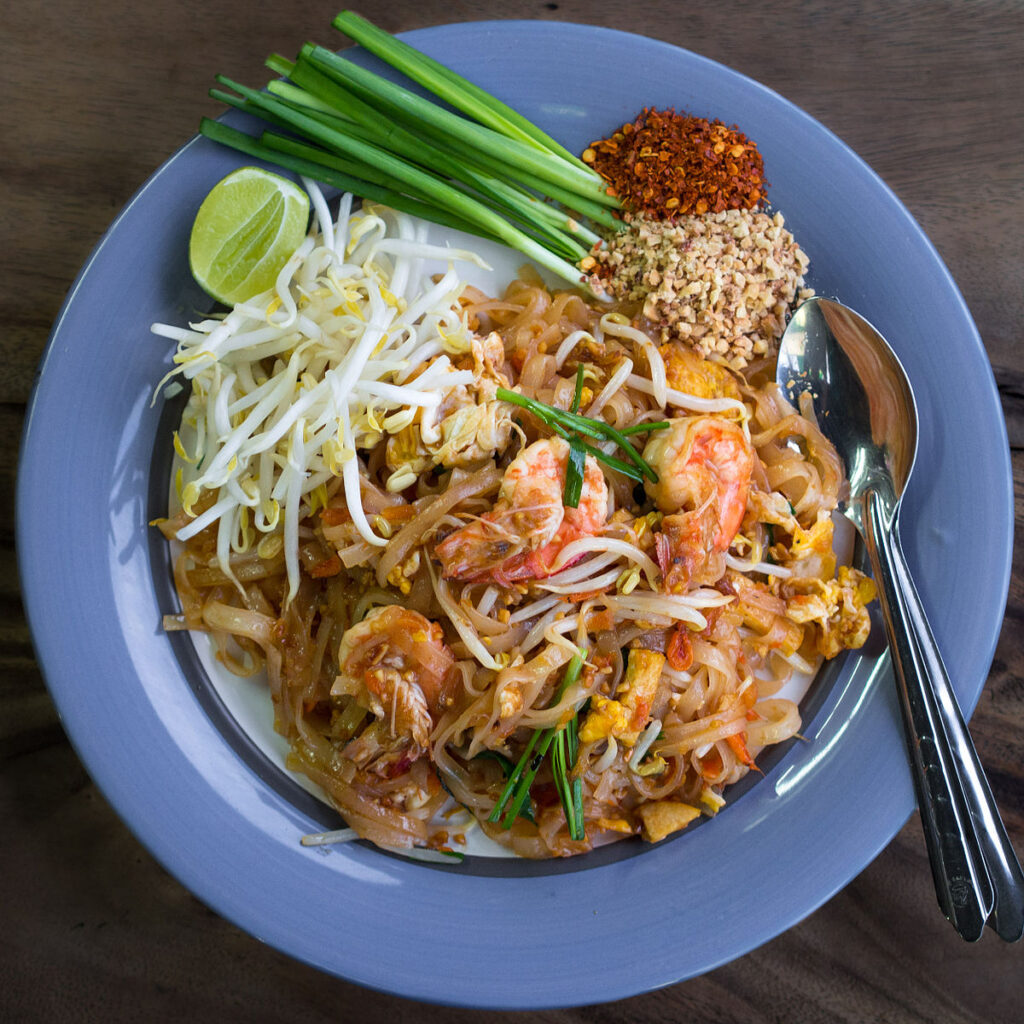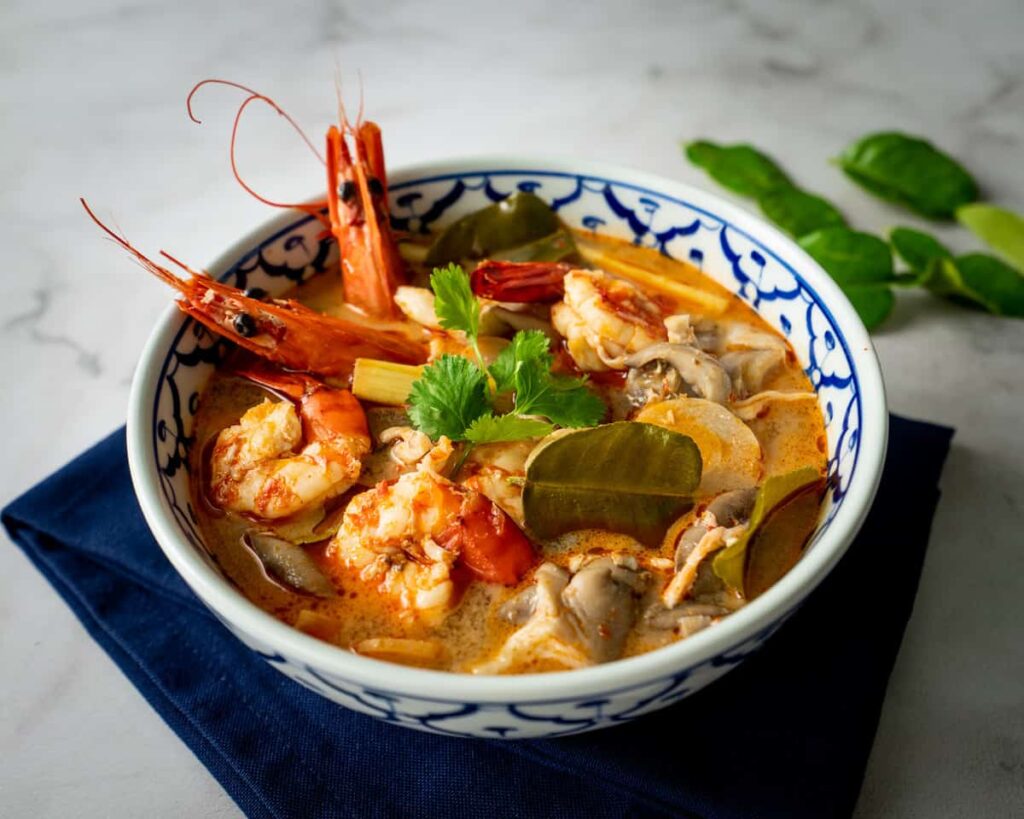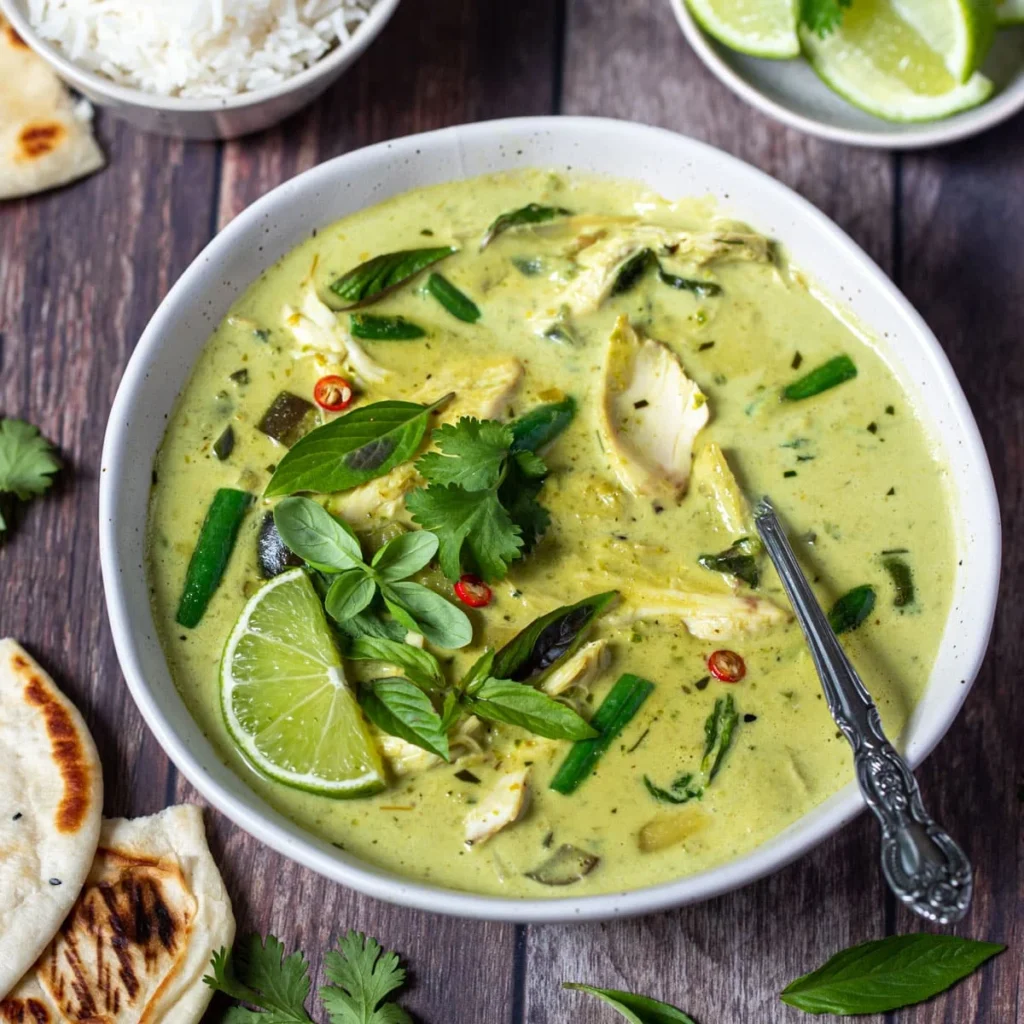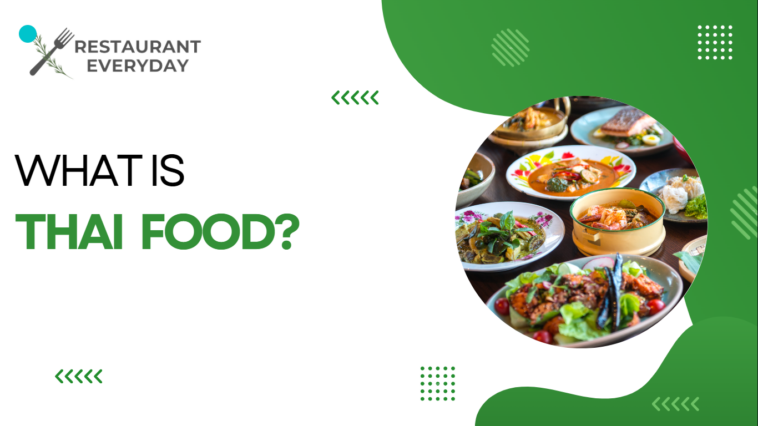What is Thai food?” Thai cuisine, renowned worldwide for its bold flavors, aromatic spices, and exquisite balance of tastes, reflects the rich tapestry of this Southeast Asian nation’s culture and is one of the best cuisines in the world.
Thai cuisine is a compelling journey for the senses, steeped in rich flavors and aromatic spices. With its exquisite balance of sweet, sour, salty, and spicy elements, Thai food offers a multi-dimensional experience that captivates the palate. Every dish reflects Thailand’s culinary prowess and vibrant cultural heritage, from the iconic Pad Thai to the fiery Tom Yum soup.
One key aspect of Thai cuisine is its emphasis on fresh herbs and bold seasonings. The use of lemongrass, galangal, and kaffir lime leaves imparts a unique citrusy zing to many dishes, while chilies add depth and heat.
Furthermore, the delicate harmony between coconut milk and traditional spices reveals the intricate nature of Thai cooking. This perfect fusion of flavors and textures sets Thai food apart as a culinary adventure waiting to be explored.
Introduction: What is Thai Food?
History: Origins and Influences of Thai Cuisine
Thai cuisine boasts a rich tapestry of history woven from indigenous roots, geographical diversity, and cultural influences.
- Indigenous Roots: Thai cuisine has deep roots in indigenous ingredients and cooking methods. Rice has been a staple in the region for centuries, and the practice of using fresh herbs and spices has long been a part of traditional Thai cooking.
- Geographical Influences: Thailand’s geography has played a significant role in shaping its cuisine. Diverse landscapes characterize the country, from fertile plains to mountains and coastal areas. This diversity of terrain has led to a wide range of ingredients being available, contributing to the variety of Thai dishes.
- Cultural Influences: Thailand has been influenced by various neighboring cultures and civilizations. The Thai people have assimilated elements from Chinese, Indian, Malay, and Khmer cultures over the centuries.
- Ayutthaya Kingdom (1351–1767): The Ayutthaya period was crucial in the development of Thai cuisine. During this time, trade with other countries flourished, introducing new ingredients such as spices, herbs, and cooking techniques. The court of Ayutthaya was known for its elaborate and refined culinary practices.
- Royal Cuisine: The royal courts of Thailand have historically played a significant role in shaping Thai cuisine. Royal chefs developed intricate and sophisticated dishes that later influenced the broader culinary landscape.
- Chinese Influence: Chinese immigrants have had a notable impact on Thai cuisine, introducing stir-frying techniques, noodles, and various soy-based sauces. Dishes like stir-fried noodles (Pad Thai) have clear Chinese culinary influences.
- Indian Influence: Indian traders and cultural exchange contributed spices, curry dishes, and the use of herbs to Thai cuisine. The concept of curries, for example, has Indian roots but has been adapted to incorporate Thai flavors.
- European Influence: During the colonial period, European powers had some influence on Thai cuisine. The introduction of chili peppers, originally from the Americas, is credited to Portuguese traders. Thai cuisine adapted the chili pepper, making it a fundamental component of many dishes.
- Modernization and Globalization: In recent decades, increased globalization and modernization have further influenced Thai cuisine. Western ingredients, cooking techniques, and international culinary trends have entered Thai kitchens.
Key Ingredients in Thai Cuisine: Spices, Herbs, and Flavors
When it comes to Thai cuisine, the key ingredients that set it apart are the unique combination of spices, herbs, and flavors. Thai food is renowned for its bold and vibrant taste profiles, achieved through carefully selected ingredients. Some of the essential spices in Thai cooking include galangal, lemongrass, and kaffir lime leaves. These aromatic spices bring a citrusy and earthy undertone to dishes, enhancing the overall flavor.
In addition to spices, various fresh herbs play a crucial role in Thai cuisine. From fragrant basil and cilantro to fiery bird’s eye chilies, these herbs add depth and complexity to every dish. Furthermore, flavors such as sweet palm sugar, tangy tamarind paste, and salty fish sauce create a harmonious balance quintessential to authentic Thai dishes. The artful combination of these key ingredients results in an explosion of flavors that tantalize the palate and leave a lasting impression on anyone who experiences this delightful cuisine.
Popular Thai Dishes: Pad Thai, Tom Yum, Green Curry
Pad Thai:

Pad Thai, often regarded as Thailand’s national dish, combines stir-fried noodles, tofu, shrimp, or chicken and a tangy tamarind sauce that leaves taste buds yearning for more. The perfect balance of sweet, sour, and savory notes makes this dish an instant hit for locals and visitors alike.
Tom Yum:

Tom Yum is another beloved Thai classic that tantalizing the senses with its spicy yet refreshing broth. This hot and sour soup features fragrant lemongrass, fresh lime juice, and a fiery kick from bird’s eye chilies. With each spoonful, the burst of flavors transports diners to the bustling streets of Bangkok or the tranquil shores of Phuket.
Green Curry:

Green Curry stands out as a rich and creamy dish packed with aromatic spices such as lemongrass, kaffir lime leaves, and galangal. The vibrant green color combined with tender pieces of chicken or tofu creates a visually stunning presentation that effortlessly captivates diners even before they take their first bite.
These dishes exemplify the complexity and balance of flavors that Thai cuisine is known for. Each dish showcases a harmonious blend of sweet, sour, salty, and spicy elements, creating a culinary experience that has captivated palates worldwide. So next time you find yourself craving an adventure for your taste buds, look no further than these famous Thai delights to transport you to the heart of Southeast Asia’s vibrant food culture.
Regional Variations: Northern, Southern, and Central Thai dishes
The regional variations of Northern, Southern, and Central Thai dishes offer a diverse and vibrant culinary landscape that reflects each area’s unique geographical and cultural influences. In the North, the cuisine is characterized by its use of fresh herbs and bitter flavors, often incorporating ingredients like lemongrass, shallots, and mint to create aromatic dishes such as gaeng hang lay (pork curry) and sai ua (spicy sausage).
Meanwhile, in the South, the cuisine is known for its bold and fiery flavors, emphasizing seafood and coconut-based curries. Dishes like massaman curry and kua kling showcase the region’s love for intense spices and rich flavors.
On the other hand, Central Thai dishes are renowned for their balance of sweet, sour, salty, and spicy flavors. Here, popular dishes such as pad thai (stir-fried noodles) and tom yum goong (spicy shrimp soup) highlight the region’s use of fresh vegetables, herbs, and fermented fish sauce.
Each region’s culinary offerings allow for a fascinating journey through Thailand’s rich cultural tapestry while highlighting how local ingredients shape traditional fare into a diverse range of distinctive tastes. Exploring these regional variations offers a delicious adventure and provides insight into Thailand’s history, geography, and traditions!
Health Benefits of Thai Food
Thai food is as delicious as it is nutritious, offering many health benefits beyond satisfying your taste buds. With an emphasis on fresh herbs, vegetables, and spices like lemongrass, ginger, and turmeric, Thai cuisine is rich in antioxidants and anti-inflammatory properties. These ingredients add vibrant flavors to the dishes and contribute to improved digestion and immune function.
Additionally, coconut milk-based curries provide a source of healthy fats, while dishes featuring fish or seafood offer lean protein with omega-3 fatty acids that support heart health. Using aromatic herbs and spices in Thai cooking also adds natural antimicrobial properties to combat infections and promote overall wellness. Beyond this, the variety of colorful fruits and vegetables in Thai dishes contain essential vitamins and minerals, contributing to a balanced diet necessary for well-being.
The traditional cooking techniques employed in Thai cuisine, like stir-frying or steaming, help retain the nutrients present in the ingredients. Whether it’s the spicy kick from chili peppers or the cooling effect of fresh basil leaves – Thai food offers a diverse palette of flavors that cater to your taste buds and support overall health and well-being.
Thai Food in USA
Thai food in USA has become a global sensation, captivating palates with its explosive flavors and unique ingredients. From the aromatic spices of green curry to the tangy sweetness of mango sticky rice, Thai cuisine tantalizes taste buds worldwide. What makes Thai food truly stand out is its delicate balance of sweet, sour, spicy, and salty flavors, creating a symphony of tastes that dance on the tongue.
Furthermore, the increasing accessibility of authentic Thai ingredients in international markets has empowered home cooks and chefs to experiment with creating their renditions of classic and modern Thai dishes. As a result, we see an evolution of traditional recipes into innovative interpretations that reflect local nuances while paying homage to their roots in Thailand.
FAQs regarding Thai Cuisine
How spicy is Thai food?
Thai food is known for its spiciness, but its heat level varies. Dishes can range from mildly spicy to extremely hot, and spice levels are often customizable to individual preferences.
What is Napa in Thai Food?
In Thai cuisine, “Napa” refers to Napa cabbage, a mild and crisp vegetable commonly used in various dishes, such as stir-fries and soups, that add texture and absorb the flavors of surrounding ingredients.
What is Tom Yum soup?
Tom Yum is a famous Thai soup known for its bold and spicy flavors. It typically includes ingredients like shrimp, mushrooms, lemongrass, kaffir lime leaves, and chili peppers.
What Thai Food is Gluten Free?
Many traditional Thai dishes are naturally gluten free, such as grilled meats, seafood, stir-fries with rice noodles, and curries made with coconut milk. However, checking ingredients and inquiring about potential gluten-containing sauces or additives in certain dishes is essential.
What Thai Food Is Keto?
Keto-friendly Thai dishes include grilled meats, seafood, and green curries with coconut milk while avoiding rice and noodle-based dishes to maintain a low carbohydrate intake.
What is Brown Sauce in Thai Food?
The brown sauce in Thai cuisine typically refers to a savory and slightly sweet soy-based sauce used in stir-fries, adding depth and flavor to dishes.
Conclusion: Embracing the Richness of Thai Gastronomy
In conclusion, the richness of Thai gastronomy offers a compelling journey through its diverse flavors, vibrant colors, and intricate culinary techniques. Embracing this culinary tradition allows us to savor delicious dishes and gain a deeper understanding of the cultural and historical significance behind each recipe. Every bite, from tangy and spicy curries to aromatic stir-fried dishes, unravels a story of Thailand’s agricultural heritage, indigenous ingredients, and traditional cooking methods.




